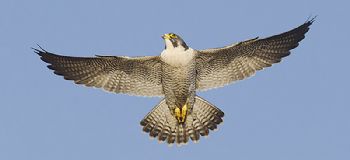
Scientists at BAE Systems (
www.baesystems.com) and City University of London say that their research into how falcons fly is inspiring new technologies for aircraft that could boost their safety in the air, aerodynamics and fuel efficiency — and could be applied in the next 20 years.
They have developed several concepts, following research into how the peregrine falcon — the world’s fastest bird — is able to stay airborne and in control at speeds of up to 200mph, even in high winds.
The technologies being developed include ‘sensory feathers’ — 3-D-printed polymer ‘hair’ filaments that would act like sensors on the body of an aircraft, providing an early warning system if it began to stall.
Similarly, more densely packed passive polymer filaments could change the air-flow very close to the surface and reduce ‘drag’.
Another technology has been inspired by the falcon’s ability to stabilise itself (after swooping or landing) by ruffling its feathers. Small flexible or hinged flaps on an aircraft could allow the wing to manoeuvre quickly and land more safely at lower speeds.
The added safety margin gained using this approach could allow future aircraft to be more compact or to carry more fuel. In addition, the research so far has shown that the flaps could potentially reduce aircraft noise.
Christoph Bruecker in City’s aeronautical engineering department said: “The peregrine falcon is the world’s fastest bird, able to dive for prey at incredibly steep angles and high velocities.
“The research has been truly fascinating, and I am sure it will deliver some real innovation and benefits for the aerospace sector.”
Clyde Warsop, a BAE Systems specialist in aerodynamic flow control, said: “Working with Professor Bruecker and his team at City, we’ve investigated how we could apply the unique abilities of the peregrine falcon to aircraft.
“Bio-inspiration is not a new concept; many technologies that we use every day are inspired by animals and nature.”